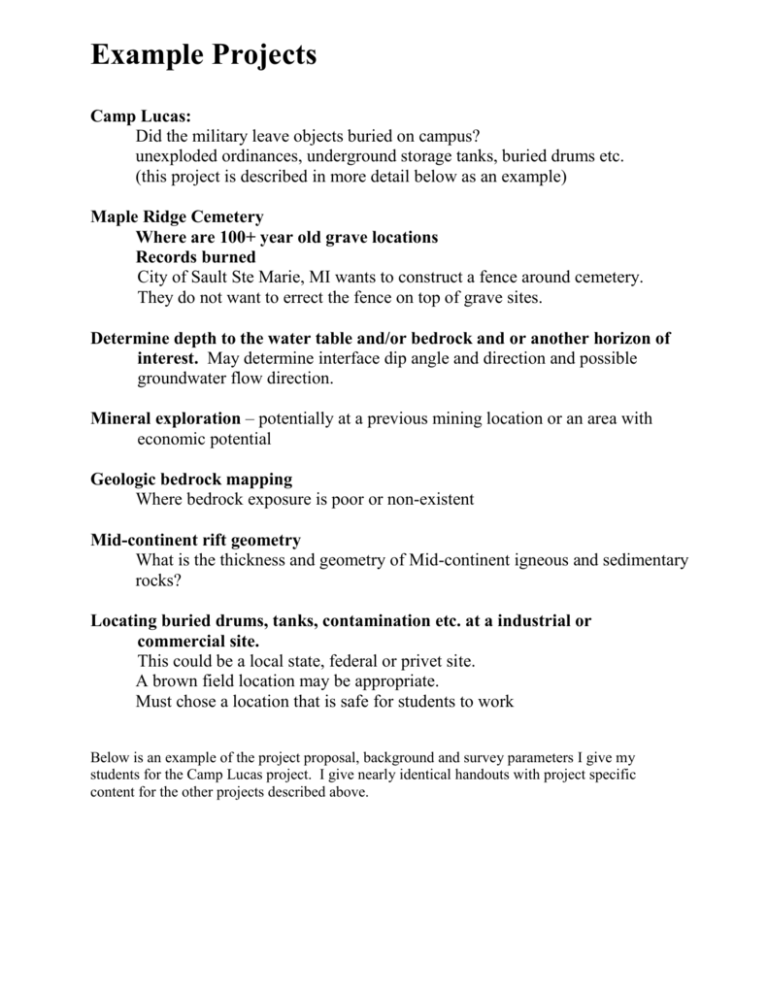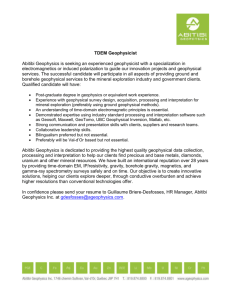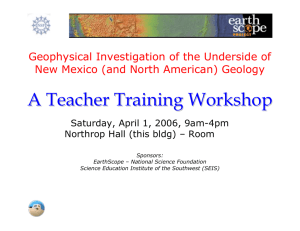Project Proposal
advertisement

Example Projects Camp Lucas: Did the military leave objects buried on campus? unexploded ordinances, underground storage tanks, buried drums etc. (this project is described in more detail below as an example) Maple Ridge Cemetery Where are 100+ year old grave locations Records burned City of Sault Ste Marie, MI wants to construct a fence around cemetery. They do not want to errect the fence on top of grave sites. Determine depth to the water table and/or bedrock and or another horizon of interest. May determine interface dip angle and direction and possible groundwater flow direction. Mineral exploration – potentially at a previous mining location or an area with economic potential Geologic bedrock mapping Where bedrock exposure is poor or non-existent Mid-continent rift geometry What is the thickness and geometry of Mid-continent igneous and sedimentary rocks? Locating buried drums, tanks, contamination etc. at a industrial or commercial site. This could be a local state, federal or privet site. A brown field location may be appropriate. Must chose a location that is safe for students to work Below is an example of the project proposal, background and survey parameters I give my students for the Camp Lucas project. I give nearly identical handouts with project specific content for the other projects described above. Example: Camp Lucas Project Proposal Paul Kelso Lake Superior State University Location of study area is southwest of the Norris Center, Lake Superior State University (LSSU) Note location on Lake Superior State University campus map 124.1 acres were acquired in 1950 by U.S. military from the City of Sault Ste. Marie, MI U.S. military returned the land to the city in the1960’s, part of which was transferred to LSSU Concerns - did the military leave behind buried objects such as: unexploded ordinances (UXO), buried drums, underground storage tanks (UST), bunkers, underground utilities, other buried materials Camp Lucas/Fort Brady(WWI – WWII era fort) is the site of previous and ongoing environmental studies Known UST’s were removed in the mid 1990’s Ongoing study by U.S. Army Corps of Engineers, Michigan Department of Environmental Quality and environmental consulting company Some of this material is available for your review on the geology network drive Survey Design: Determine which instrument(s) to use for survey Why did you choose these instruments? Why would this instrument likely record an anomaly (for each instrument)? What are the likely anomalies characteristics you would expect with each instrument? Design a survey lines/grid to achieve the above goals Why did you choose this survey design? Determine station spacing Why did you choose this configuration? It may be different for different instruments Models of potential anomalies Develop forward models for one or more examples of expected anomalies Use realistic values for the materials’ geophysical properties Models must be developed for each instrument suggested Models must be presented for all proposed instruments Costs Personnel, equipment, overheat, profit, etc. (see Planning a Geophysical Survey below) You will have four geophysics field crews (3-4 people each) to collect data for this project during three afternoons or one full day Project Proposal Assignment (Group assignments): Description of your project proposal (minimum 2 pages per group plus figures) Model anomalies with figure captions must be included in addition to two pages of text 15 min. presentation of your proposal to class All students must give part of presentation Include detailed answers to all of the above questions Above issues must be included/considered Information provided prior to field survey Overview of physical principles of potential techniques (gravity, magnetics, electromagnetics, ground penetrating radar, resistivity, induced polarization, self potential, seismic refraction) Basic equations and/or software for forward modeling of body geophysical responses for likely methods Introduction to operation of equipment available for project Including how long measurements take Survey consideration Brainstorm, think-pair-share or I may provide this (see below) Planning a Geophysical Survey Paul Kelso Lake Superior State University Things to consider/include in a project proposal Survey objectives Geophysical target Geophysical responses to target Anomaly amplitude Anomaly half width Costs (ultimately Financial, e.g., Thomas Boyd’s web site http://galitzin.mines.edu/INTROGP/index.jsp) Personnel Field time – including travel, set up, survey execution Processing time Reports, presentations- including preparation time Operating costs - logistics Equipment Geophysical instruments, computers, vehicles, etc. Purchase, rent, subcontract? Software purchase/lease Training – equipment, software, etc. Contingencies – for unexpected complications – not if but when Overhead – administration, insurance, building, facilities, consumables, etc. This is usually calculated as a % of above expenses (50-100%) Profit – how much are you going to make? Logistics Transportation to survey location Access to survey area (terrain, weather, permission, etc.) Political, social and religious considerations Supplies, food, shelter, etc. Survey Design Geophysical methods What instruments are you going to use and why? What are the anomaly characteristics you expect with each geophysical technique? Profiling vs. mapping Station spacing Spatial aliasing Temporal aliasing (base stations and seismics) Line configurations Line orientation - considerations Perpendicular to strike, VLF source direction Line spacing Smaller than the width of the body of interest Line length Must be longer than anomaly so one can recognize the background signal Tie lanes To check the reproducibility of data Noise Common sources: coherent vs. incoherent noise



